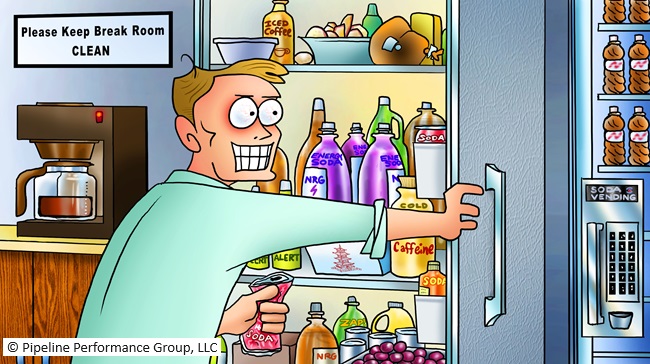It’s 2 am on your fourth consecutive night shift, and the fatigue is setting in. If you have an elliptical nearby, do you hop on and hope for a quick burst of energy? Do you turn the music up or pick a TV channel that is broadcasting something more entertaining? Maybe you grab a bag of Hot Cheetos, or a cup of coffee. Hopefully you have several fatigue mitigation options available, and you know what works best for you when sleepiness sets in.
When it comes to combatting fatigue, many shiftworkers rely on caffeine. You likely know many of the warnings. Caffeine can interfere with your sleep patterns, making it harder to fall asleep and reducing the quality of your sleep. High doses of caffeine can lead to increased anxiety and jitteriness which can impact your focus and situation awareness. Caffeine causes stomach upset or acid reflux in some people and can temporarily increase heart rate and blood pressure. Long-term, regular consumption of caffeine can lead to dependence, making you feel that you need caffeine to function normally.
Caffeine can be effective, however, when used strategically and in moderation. Healthy ways to manage your caffeine intake include:
- Limit your daily intake of caffeine from all sources to no more than 400 mg per day, which is roughly equivalent to four 8-ounce cups of regular coffee.
- Be mindful of your caffeinated beverage choices, especially when it comes to specialty coffee and tea beverages, or energy drinks that may contain higher levels of caffeine, sugar, artificial colors, and/or artificial flavors. A typical 500 ml Monster energy drink contains approximately 160 mg of caffeine and 27 g of sugar, while a medium Starbucks blonde caramel macchiato has approximately 170 mg of caffeine, 270 calories and 34 g of sugar.
- Choose your sources of caffeine wisely; opt for natural sources of caffeine like coffee or tea which contain antioxidants.[1] Caffeine is also found in some foods, either naturally or by being added during the production and packaging process.
- Avoid caffeine as you approach your sleeping hours to prevent sleep disruption. Caffeine is a stimulant, which may make it harder for you to fall and stay asleep.
- Balance your caffeine intake with plenty of water to stay hydrated. Caffeine is a diuretic, which means it can cause your body to lose water through more frequent urination.
- If you find that caffeine is a frequent go-to for you, consider cutting back, but do so gradually so that you can avoid caffeine withdrawal symptoms such as headache, fatigue or depressed mood. Symptoms of caffeine withdrawal typically peak after 1-2 days and can last up to 9 days.[2]
Using caffeine in moderation can be a reasonable fatigue mitigation tactic, but it should not be the only component of your personal fatigue mitigation strategy. For a successful strategy incorporate other elements such as alertness exercises, engaging in conversation with a coworker, adjusting your desk, adjusting the room temperature and lighting, or grabbing a healthy snack.
MANAGING FATIGUE EDUCATIONAL PROGRAM
Christina Via © 2024 Please Distribute to Others.
[1] Moderate Amounts of Coffee are the Best, Harvard Health Publishing, November 1, 2020, https://www.health.harvard.edu/staying-healthy/moderate-amounts-of-coffee-are-the-best
[2] Caffeine Withdrawal, National Library of Medicine, August 8, 2023, https://www.ncbi.nlm.nih.gov/books/NBK430790/#:~:text=The%20severity%20of%20symptoms%20vary,and%20feeling%20foggy%2Fnot%20clearheaded.




